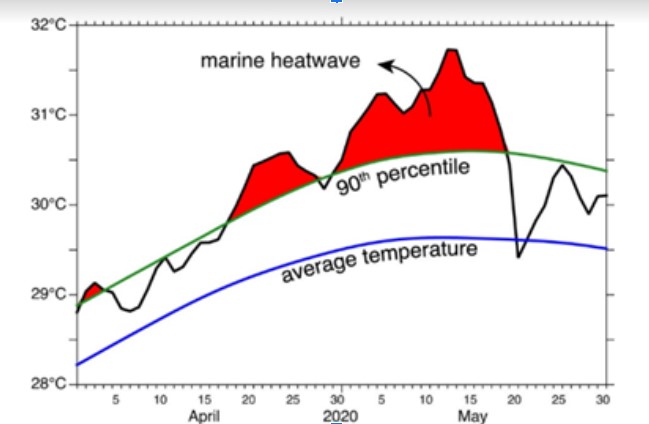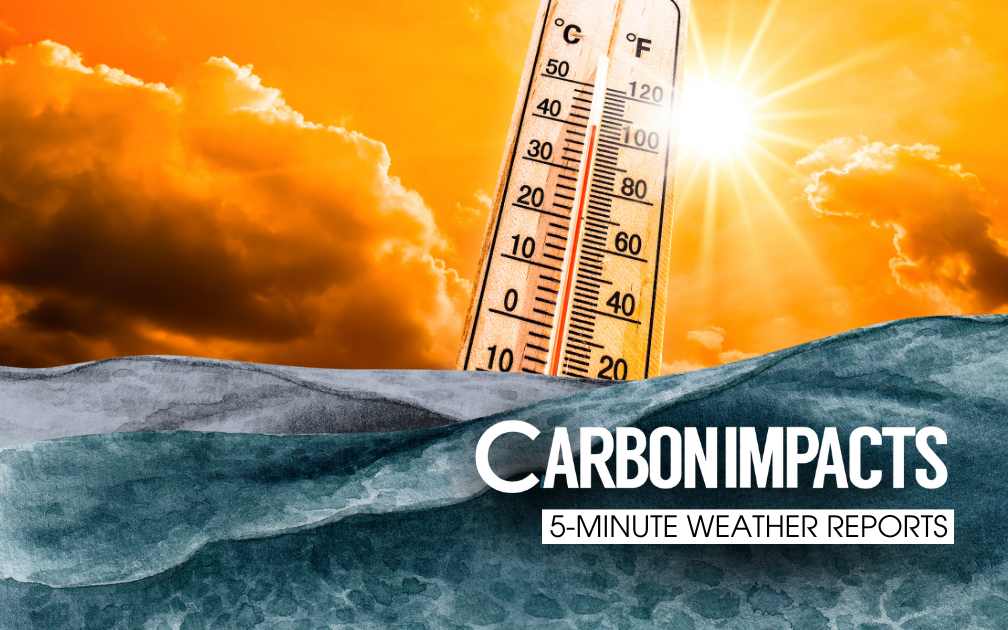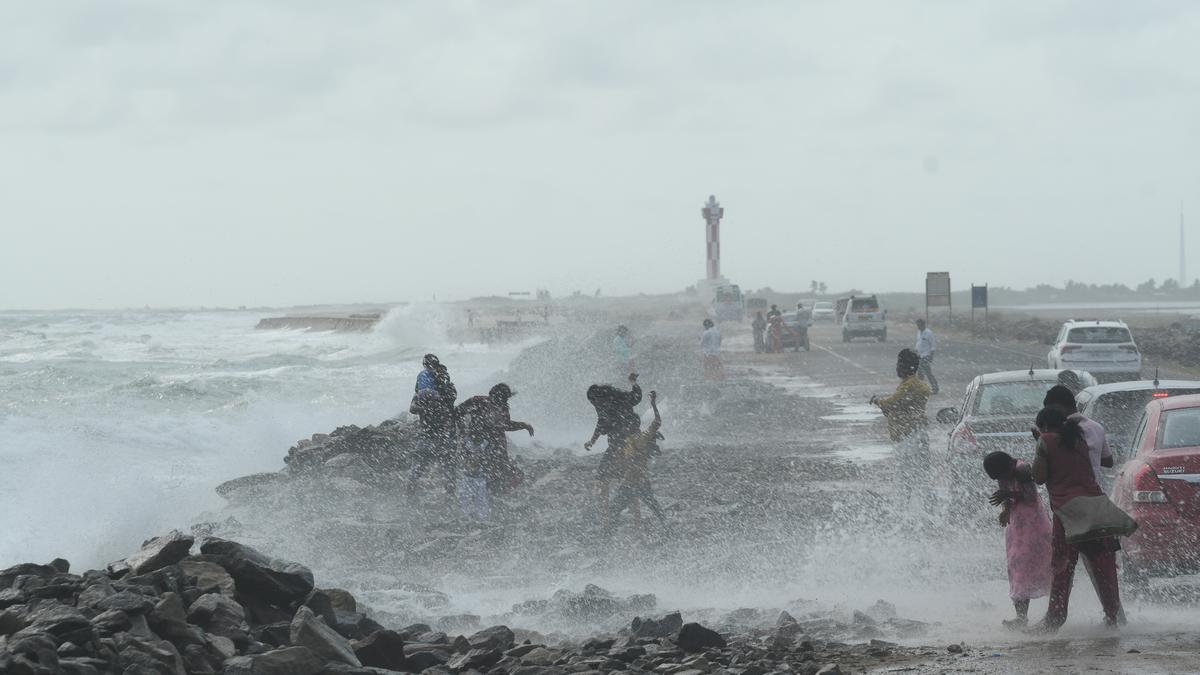Rising ocean temperatures impact fish catch and physiology in Chennai
A bleak future for the seafood industry? In the first of a two-part series, Carbon Impacts explores how climate change led ocean warming is impacting seafood catch.
By Priyanka Thirumurthy / Jun 26, 2023
It was a sultry September evening, when we sat down with 59-year-old Palayam, a fisherman from Chennai, whose family has depended on the seas for a living for over five generations. Though diminutive in appearance, Palayam’s rough hands and lined face offer a glimpse into his hard life at sea. His grim countenance however lights up when he recalls growing up near the ocean on a steady diet of seafood. Delectable traditional recipes passed on for generations in his community were made with fishes like the Musal Paarai (Paarais are a species of Jackfish), Kondudal Paarai (a Jackfish species), Vanjaram (Seer fish), Kaala meen (Indian Salmon), Mosidi (Orange snapper) and Kurali (Emperor fish).
"We were eating seafood at least 5-6 times a week. Only after the family was fed, was the remaining catch taken to the market to sell. We were content and earned enough," he explains. "But today, the catch I bring back is only enough to sell in the market and make enough money to run my family. On some days, I even come back with nothing worth selling," he admits defeatedly.
This fisherman can barely remember the last time he ate seafood, even three days in a row.
"We have been eating vegetables and eggs for the past five days. My children have grown up without seafood as a prominent part of their diet. I can't constantly afford other proteins like chicken or mutton,“ he says. "Species like the Malabar King fish, seer fish, Silver pomfret and King Crabs, which my grandfather so casually brought home, are now not that easily available in the sea. And even if I want to buy them, the rates are just unaffordable," he adds.
This fisherman's lament not only echoes through his community but also moves along the upper echelons of the supply chain in the fishing industry in Chennai, as species that were once easily available are now proving to be near impossible to catch in large quantities. While overfishing and pollution are major stressors for the marine environment, scientists are now finding that climate change and the resultant warming of seas and other water bodies are proving to be the fatal blow that has completely changed the ecosystem. A growing body of scientific evidence, backed by anecdotes from the fishing community and hoteliers, point to a bleak future for the seafood industry if the climate emergency remains unaddressed.
CONNECTING SCIENCE TO EXPERIENCE
Research spanning the last two decades has repeatedly shown that increasing sea-surface temperatures are affecting the fish population by harming both their fundamental source of sustenance and their habitats. For instance, there has been a consistent effort to establish the link between marine heatwaves, reducing phytoplankton and increasing coral mortality.
Marine heatwaves (MHW) are periods of extremely high temperatures in the ocean (above the 90th percentile which means temperatures are in the top 10% from the data). These events cause habitat destruction due to coral bleaching, seagrass destruction, and loss of kelp forests, affecting the fisheries sector adversely.

Image: Example of a marine heatwave in the Bay of Bengal during April–May 2020. Image Source: Advancing Earth and Space Science
These heatwaves used to be rare in the tropical Indian Ocean, but now they have become an annual affair. Studies have reported high Sea Surface Temperature (SST) conditions in the western Indian Ocean, Arabian Sea, and the Bay of Bengal region (Andaman Sea) and also point out big impacts on the marine ecology due to intense warming in these regions, suggesting that marine heatwaves are behind these events.
According to a research paper by Advancing Earth and Space Science, western Indian Ocean reported 66 marine heatwave events during the 1982–2018 period, in which 21 events occurred during June–September months (Indian Monsoon season) of every given year. Meanwhile, the north Bay of Bengal region witnessed 94 marine heatwave events, and 34 out of these occurred during June–September.
There was a significant rise in annual Marine Heatwave frequency during 1982–2018 at a rate of 0.14 events per year for the western Indian Ocean and 0.09 events per year for the north Bay of Bengal. The western Indian Ocean region experienced the largest increase in marine heatwaves in the region at a rate of about 1.5 events per decade, followed by the north Bay of Bengal at a rate of 0.5 events per decade.
IMPACT OF WARMING ON FOOD CHAIN IN OCEANS
Phytoplankton essentially forms the basis for aquatic food webs. It is one of the main sources of sustenance for primary consumers such as zooplankton, small fish, and crustaceans. These primary consumers are in turn fodder for bigger fish, small sharks, whales and the like.
"There is an overall decline in marine phytoplankton mass in the Indian seas, as observed from the chlorophyll data. This is more in the Arabian Sea as compared to the Bay of Bengal. The decline in phytoplankton in the Bay of Bengal is observed in some of the coastal seas and the northernmost part of the basin. We find that this can cascade through the food chain and affect the fisheries too," says Dr Roxy Mathew Koll, a climate scientist from the Indian Institute of Tropical Meteorology.
Laboratory experiments conducted on seven species of phytoplankton found that while the rate of multiplication was faster at higher temperature, the decay too set in earlier.
Corals meanwhile are made up of thousands of tiny animals called polyps. They provide habitat for a large variety of marine life, including various sponges, oysters, clams, crabs, sea stars, sea urchins, and many species of fish. According to scientists, corals occupy less than 0.1% of the ocean's surface area but support close to 25% of marine biodiversity.
A paper titled 'Exceeding 1.5°C global warming could trigger multiple climate tipping points' explains that the entire marine food web is in danger when corals collapse. Ocean acidification, which essentially signifies increased pH balance of the water due to absorption of excess carbon dioxide has been mentioned as a factor that is worsening the existing crisis.
'When water temperatures exceed a certain threshold, coral irreversibly expel their symbiotic algae resulting in coral bleaching, thereby triggering coral death. Ocean acidification worsens warming-induced degradation. Coral collapse would remove one of the Earth’s most bio-diverse ecosystems, affecting the wider marine food web, ocean nutrient and carbon cycling, along with livelihoods of millions of people worldwide.
Experts say that marine life in the Bay of Bengal, which is experiencing more heatwaves than ever, is facing extreme stress as outlined in this study.
"Our most recent research shows that the Bay of Bengal is susceptible to marine heatwaves, and that the intensity and frequency of these heatwaves are increasing. Marine heatwaves have been found to be destructive for the marine ecosystem, leading to mass mortality of corals, marine invertebrates and fishery collapse," confirms Dr Roxy Koll.
On the ground in Chennai, powerful first hand accounts from fishermen, seafood suppliers and procurement personnel give voice to the changes happening within our seas and oceans.
WHAT IS HAPPENING TO FISH?
"Even 10 years ago, if I took my boat and went up till Kotturpuram I would be able to get at least 10 kilos of Kaala Fish (Indian Salmon) where the river meets the sea, but now getting even 2 kilos is considered a jackpot," says Palayam.
This is a consistent pattern noticed across Chennai. From suppliers and procurers to the chefs of top restaurants, the shift in what is being caught at sea has left the industry in a fix.
"Until 15 years ago, we would get fish like Sudumba (False Trevally) and Sura (shark) very easily from the sea. Even in prawns, we were getting six varieties from the sea and now that has reduced to three. The same goes for fish like Mahi Mahi, mussels and lobsters," says Vijay Kumar, the owner of Blue, a seafood contractor that supplies to 40 hotels and restaurants in Chennai and neighbouring Mahabalipuram.
"I don't know what has happened. Have we eaten too much? Is it pollution or is it climate change? The fish have gone very deep into the sea and they seem to be moving to colder waters. Fish that we would get near the surface before are now getting caught in nets meant for deep sea fish," he adds.
The supplier is right on all three counts, say researchers and marine scientists who have been studying the effects of global warming on seafood catch.
"The way we see it, unsustainable fishing and habitat degradation are like comorbidities for the fish, and climate change is like COVID-19. Any one of these issues by itself may not be life threatening, but together they impact the population of species heavily," says Dr E Vivekanandan, former principal scientist at Central Marine Fisheries and Research Institute (CMFRI). "As far as climate change and fish population are concerned, there are three major issues. One is the warming sea water, the second is the acidification of oceans and the third is reduction in oxygen concentration in some locations in the sea. All of these problems cause fish, which are very mobile organisms, to keep moving to more favourable conditions."
WHAT HAPPENS IN WARMING WATERS?
According to a study by the Central Marine Fisheries and Research Institute (CMFRI), certain fish have been found to change their behaviour and descend to deeper waters in the last two decades, as temperatures have risen.
The study that focussed on mackerel, a fish that normally occupies surface and subsurface waters, stated, ‘During 1985-89, only 2% of mackerel catch was from bottom trawlers, and the rest of the catch was contributed by pelagic gear such as drift gillnet. During 2003-2007, it is estimated that 15% of mackerel catch was contributed by bottom trawlers along the Indian coast.’
In another report, Ivan Nagelkerken of the University of Adelaide was quoted explaining this phenomenon.
“Species are extending their ranges pole-wards as the oceans warm due to climate change. This process, known as tropicalisation of temperate ecosystems, means tropical species are mixing with temperate species and creating novel ecological interactions.”
According to Nagelkerken, mixed shoals of tropical and temperate species became less cohesive under future climate conditions and showed slower escape responses from potential threats. Strong shoal cohesion and coordinated movement, whether to acquire food or evade predators, are important for fish survival.
This movement of species from traditionally mapped areas is being observed by the fishing community across the world, from Canada to even Ghana.
A study titled 'Disentangling tropicalization and deborealization in marine ecosystems under climate change' claims that species are moving towards the poles in search of cooler waters. Species that are usually found in subtropical and tropical underwater environments for instance are now being found in temperate environments. This is a cause of concern as it clearly proves the movement of fish from tropical waters that were considered the right temperature for their habitation to temperate waters that are cooler by virtue of being closer to the poles.
According to a report by the Intergovernmental Panel on Climate Change (IPCC), ocean acidification and global warming are interfering with the way fish interact in groups, posing a threat to their survival which could affect seafood supplies.
Marine ecosystems worldwide have shown an increased dominance of warm water species following seawater temperature rise, with parallel changes in the species composition of fish catches since the 1970s, according to the IPCC report.
OCEAN ACIDIFICATION
Ocean acidification too is a byproduct of global warming. It occurs because human activities increase the levels of carbon dioxide in the atmosphere and in turn more of the greenhouse gas is dissolving into the ocean. The ocean's average pH level is supposed to be around 8.1, which is basic (or alkaline). However, as more CO2 is released into the atmosphere, the ocean continues to absorb more of the greenhouse gas, resulting in a pH decrease and the ocean becoming more acidic.
Dr Vivekanandan points out that acidification is dangerous because it affects the fish's physiology.
"Marine organisms have a certain calcium content based on the species. When acidity of the ocean increases, it reduces calcification. When fishes are juvenile they have to form a vertebral column and due to the chemical reaction caused by the increased addition of carbon dioxide to sea water, more bicarbonates are forming and affecting the calcium content in fish. This affects both juvenile and larger fish and the vertebrae of these organisms display deformities," he explains.
In addition to this, scientists also observe that the size of various fish is changing due to temperature rise and acidification. These findings are further supported by anecdotes from seafood procurement personnel and chefs from Chennai.
DOES SIZE MATTER?
Chef N Kannan, a veteran in the hotel industry, who has worked with star hotels in Tamil Nadu for 25 years, witnessed first hand the shrinking of the prawns he was serving his customers.
"We need 400-500 gm of fish to present to our chefs," says D Shankar, who handles procurement of seafood for The Park in Chennai. "But we don't get the grammages. When asked, vendors just put their hands up in the air and blame climate change. This leaves us with no choice but to limit our menus to provide the best quality and quantity," he adds.
Squids, for instance, he says, are required to be a minimum width of two inches to be served in a 5 star hotel. But these are no longer available.
“We used to order mackerels as they would give a lot of meat. But now we no longer get the larger-sized mackerel, so we have moved to using the red snapper," he says.
Chef Kannan, too, points out that the mackerels and Kaala fish (Indian Salmon), if they ever got it, were becoming smaller in size.
Chef Ashutosh Nerlekar, who runs the kitchen at The Park in Chennai confirms this observation.
“In a hotel like ours, seafood like lobsters have to be a certain size to be fit to be served,” says Chef Ashutosh. “We currently grill our lobsters and if the size is too small, it shrivels up and we can't present it. The shell looks larger,” he adds.
Fishermen and one section of scientists believe that the reduction in the size of individual fish is because of overfishing, which does not allow marine life to grow to their full extent. While this could be one reason, studies show that warming waters due to climate change is also responsible for the change in the physical attributes of the catch.
Evidence from theoretical modeling and empirical data has shown that one of the main expected responses of marine fishes to ocean warming is decrease in body size. One reason for this is that the oxygen supply required by large fish cannot be met in such habitat. Another reason offered is that the metabolism of fish increases in warmer waters.
"When the temperature increases, the metabolism of fish is faster and their oxygen consumption increases. Lot of energy is spent on respiration. Growth of the fish reduces and is faster,” says Dr Vivekanandan. “It achieves one year’s growth in just 7-8 months. So the fish remains smaller and doesn’t reach a larger size. Its longevity also reduces. Because of the higher temperature, everything is happening at a very fast pace,” he explains.
If this trend continues, scientists predict that many commonly-eaten fish could face extinction due to climate change.
Another study titled 'Climate change ‘double whammy’ could kill off fish species', has stated that climate change will not only force fish to evolve to a smaller size, but it can also reduce their ability to move to more suitable environments.
Professor Chris Venditti, an evolutionary biologist at the University of Reading, and co-author of the study has said that fish will get left behind in evolutionary terms as sea temperatures rise faster than ever. And this in turn could have serious implications on food security as species we depend on for sustenance become increasingly scarce in years to come.
So how do we battle this fast-approaching problem? We will bring you the information in the next story of this series.


